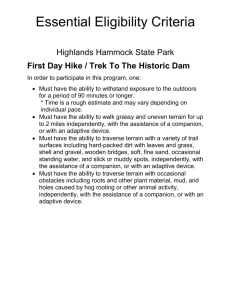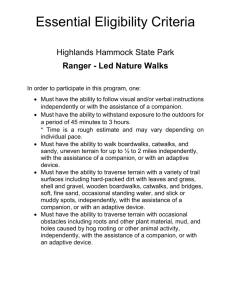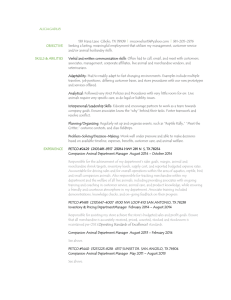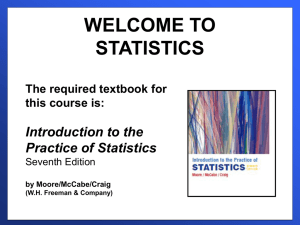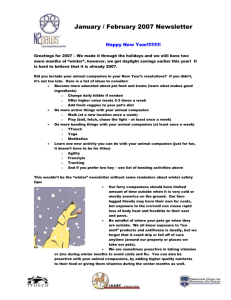book review oxford companion, sept 2003
advertisement
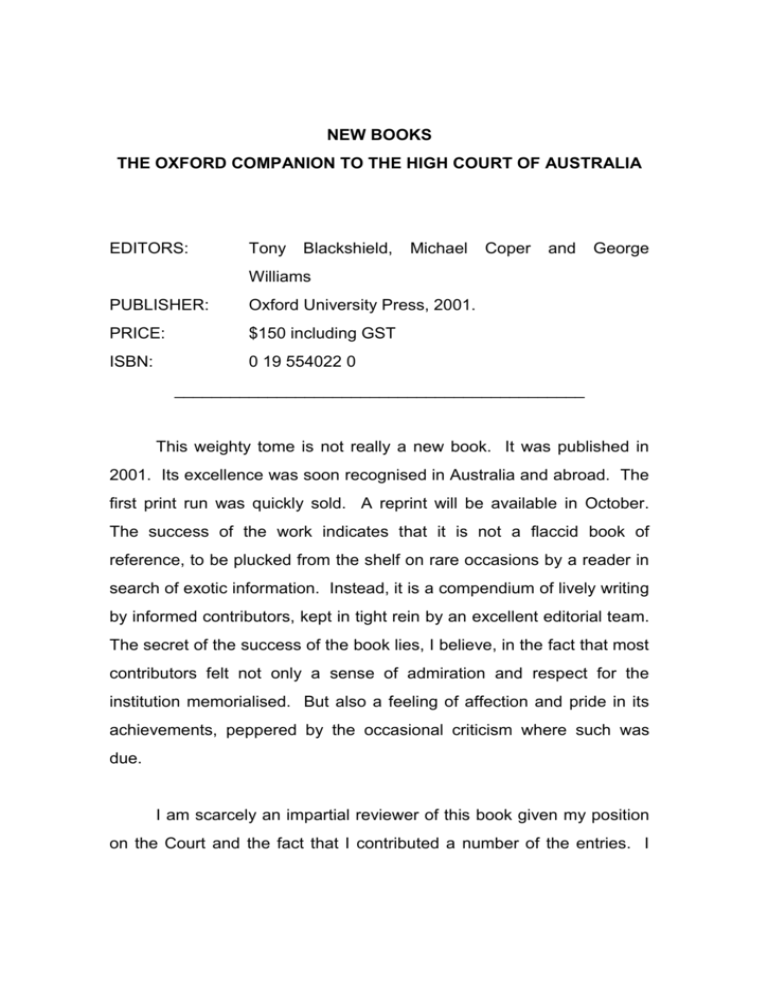
NEW BOOKS THE OXFORD COMPANION TO THE HIGH COURT OF AUSTRALIA EDITORS: Tony Blackshield, Michael Coper and George Williams PUBLISHER: Oxford University Press, 2001. PRICE: $150 including GST ISBN: 0 19 554022 0 ____________________________________________ This weighty tome is not really a new book. It was published in 2001. Its excellence was soon recognised in Australia and abroad. The first print run was quickly sold. A reprint will be available in October. The success of the work indicates that it is not a flaccid book of reference, to be plucked from the shelf on rare occasions by a reader in search of exotic information. Instead, it is a compendium of lively writing by informed contributors, kept in tight rein by an excellent editorial team. The secret of the success of the book lies, I believe, in the fact that most contributors felt not only a sense of admiration and respect for the institution memorialised. But also a feeling of affection and pride in its achievements, peppered by the occasional criticism where such was due. I am scarcely an impartial reviewer of this book given my position on the Court and the fact that I contributed a number of the entries. I 2. know all of the editors and most of the writers and it would be awkward for me to voice serious criticisms of some of the contributions. Although not specifically produced for the centenary of the High Court (like the cuff links, scarves and other low priced memorabilia that are fast selling out), the book is obviously inspired by the virtual century that it chronicles. The human mind revels in jubilees and centuries, seeking to stamp on the whirligig of time the proportions in which comprehension by our species feels comfortable. It is interesting to speculate upon what a bicentenary book on the Court will look like. If Griffith and his two colleagues could come down off the wall of the No 1 Court in Canberra, or emerge from the pages of this book to take their seats in the present Court, I doubt that they would be much surprised by what has come of their early handiwork. A century hence; that is a different matter. This Companion is modelled on the brilliant predecessor published by the same house in 1992, the Oxford Companion to the Supreme Court of the United States (see review 67 ALJ 960). The sequence is significant. In 1994, at the Australian National University in Canberra, Professor Michael Coper launched the idea and gathered a working group to breathe life into it. In 1996 he was joined by (now Professor) George Williams and OUP encouraged the concept with some well placed financial support. Professor Tony Blackshield then joined this inner sanctum. By 1996, the whole enterprise was underway. As with the earlier Companion, the text followed an alphabetical format. The entries were respectively to be on people, cases and concepts associated with the Court. The editors invited contributors with an 3. established expertise or a known willingness to bone the subject up. From the first entry on the AAP Case in 1975 to the last one on Zimes v Prothonotary of the Supreme Court of New South Wales (1957), the entries are packed full of information, much of it fresh and new; some of it surprising and quite a bit of it controversial. The entry on the Dixon Diaries by Phillip Ayres, for example, was published before that author's recent biography of the great Chief Justice. It reveals the list of his ailments, intense working habits, criticisms of his colleagues (bordering on contempt in the case of Latham) and his conduct in advising Executive Government that would certainly be regarded today as completely impermissible. Like many people who keep detailed diaries, Dixon was probably ambivalent about their content. On the one hand, they allowed him to let off steam in a way that his rather rigid personal values forbade in ordinary intercourse. On the other hand, he must have known (and probably intended) that one day they would be accessed by historians. Who would now contend that the diaries could be dismissed as irrelevant as a source for elucidating the values that, consciously or unconsciously, influenced Dixon's judicial writing? In the entry on "Sex", the changing mores of society and their impact on the judicial approach are traced through a number of cases in criminal law and censorship. On the latter, we can almost see Barwick, urbane, ever-confident and cigar in hand, describing the magazine considered by the Court in Crowe v Graham (1968) as offensive to the "modesty of the ordinary 4. man", although it "might pass muster in a tap room or smoke concert". McTiernan's well known prudishness comes out in his dissenting opinion in Transport Publishing v Literature Board of Review (1956). Whereas Dixon, Kitto and Taylor were prepared to view the cartoon books in issue in that case as about "love, courtship and marriage" written for ordinary folks, McTiernan was horrified, expressing the opinion that the stories were "likely to inflame the venereal passions of the classes of young persons likely to devour this trash". In the present age, those cases are rarely read. They are rescued from oblivion by this Companion. Reading these cases, and many others, it is difficult to take seriously the pretence that the strong personalities and values of the judges described in this book had no effect on their judicial opinions. The entry on legalism, by Stephen Gageler opens with the well known words of Chief Justice Dixon in 1952 at his swearing in as Chief Justice. "Legalism" was, as the entry says, "the dominant theme of the judicial style of the Court for much of the twentieth century and the antithesis of realism". But between theory and practice, there is sometimes a great gulf. Many of the more interesting entries in the Companion constitute short biographies of the forty-three Justices who had been appointed to the time of publication. Only Justice Heydon, appointed 2003, is missing from these biographies. But he is represented in the Companion, having written the entry on Evidence Law, a remarkable digest of a huge number of important decisions. My own favourite amongst the 5. biographical entries is the one on Justice Evatt by Peter Bayne. There is no gainsaying that Evatt was a great judge. Had he stayed longer, his influence would have been still greater by the sheer force of his remarkable intellect. Yet, ironically, Evatt's greatest success in the Court was from the Bar table in his successful attack on the legislation in the Communist Party case (1951) - a story that is well told by George Williams who never ceases to draw parallels to our contemporary world. Another excellent biographical entry is that on Windeyer, still one of the most influential of the Justices. Justice Bruce Debelle has written an affectionate piece, which is unsurprising given that he served as Windeyer's Associate. The list of High Court Associates is itself a remarkable entry. In the early years of the century, the Justices thought nothing of employing their relatives. But by mid-century, the recruitment of able young lawyers (most of them male) now reads like a list of leaders of the Australian legal profession. Judges, politicians and academics make up many of the names of the Associates. Only two of them have so far gone on to serve as Justices themselves - McTiernan, who worked for Rich and Aickin, who served with Dixon. One of the editors of the Companion, George Williams, was Associate to Justice McHugh. When work on the inescapable intricacy of current cases becomes tedious, it is a pleasant journey to open the Companion and just to browse amongst the entries. Some are nostalgic like "Appointments That Might Have Been". Some are evocative of their era, like the entry 6. on the Chamberlain case or the Mabo decision. Some are fine pen pictures of the changing nature of the Court and its work over the century, such as the entry on "foreign precedents" and the statistical table attached to it. Appropriately enough, the excellent entry by Jessica Milner Davis and Troy Simpson on humour is not excessively long. Tony Blackshield wrote an insightful entry on "Judicial Reasoning" and "Jurimetrics". The latter contains the only item that I have so far not understood: a three dimensional view illustrating, in spatial form, the "psychological space that [the Justices] all inhabit". I am still searching for that space. The pain of the "Murphy Affair" is written up by Tony Blackshield. It brings reminders, to those who lived through it, of the institutional and human toll of that time. The entry on personal relations is a reminder of the strong likes and dislikes that are almost bound to arise in an institution of small numbers and strong convictions forced by fate, without links of blood or affection, to live closely day by day with each other. To the formal entry on that topic is added a coda by Sir Anthony Mason. He reminds judges who follow that they should not feel too distressed by the fact that they do not always like each other. After all (virtually without exception) they have absolutely no say in who their companions will be. There is a good entry on "Sexual Preference" by Kristen Walker (who was one of Mason's Associate). I would have preferred the subtitle "Sexual Orientation". But the fact that this item is there at all is a sign of 7. the changes that have come over the Court in the century of its existence. It is unlikely that the changes will cease in our age. There are useful legal essays on disqualification, tied votes, the use of metaphor, etiquette and procedures before the Court. The work is rounded with a list of the civil honours awarded to High Court Justices; a schedule of acknowledgments of the splendid photographs that illustrate the pages; and a list of the cases that are mentioned, some of them as major entries, most for reference. At the end, there is a list of names and a subject index, bringing to a conclusion 800 pages of concentrated text. Very few of the entries are too long. Some of them are tantalisingly over brief. Some decisions that would be on my list have not warranted an entry on their own. It is in this respect that the Companion shows some defects when compared with its United States counterpart. On the other hand, the American Court had two centuries of cases to cover and the Australian work embraced, like the High Court itself, a wider dimension of general law. There are a few slips. But not many. Justice Gummow's biography wrongly records that he was appointed "AO" in 1997. It was AC, now the highest level of civic honour. The entry on Chief Justice Gleeson wrongly describes his sporting prowess but gets right his skills in debating and oratory that he learned at school. In the schedule of civil honours, Evatt's post-Court status as a member of the Privy Council is omitted, although it was much prized by him and I well remember it being used in the writs issued in his name as Chief Justice of New South Wales towards the end of his career. Yet these are trivial complaints 8. about an outstanding and accurate work of reference, scholarship and interest. Perhaps at appropriate jubilee intervals supplements will be issued. The Oxford Companion to the Supreme Court of the United States was quickly followed by the Oxford Guide to United States Supreme Court Decisions. Such an additional volume would be a welcome contribution. Texts of this kind, if well indexed, can be of great practical use to busy practitioners in gaining rapid entry to a large array of a Court's doctrine on particular subjects, until new decades make them outdated and nostalgia and history kicks in to appeal to a different audience. In short, this book is well named as a Companion. There are doubtless more lively companions in this world. But for lawyers, with a proper appreciation of the highest court of a nation, operating under the fifth oldest written Constitution in the world, this Companion is a good friend, with useful anecdotes on things we never knew and reminders of other things we should not have forgotten. The editors, their research assistants, the contributors and the publishers deserve praise for a remarkable achievement. It helps put the centenary of the High Court of Australia into its proper human and intellectual context. It is one of those books that can be read at once with pleasure, interest and advantage – and not just by lawyers. Michael Kirby NEW BOOKS THE OXFORD COMPANION TO THE HIGH COURT OF AUSTRALIA EDITORS: Tony Blackshield, Michael Williams PUBLISHER: Oxford University Press, 2001. ISBN: 0 19 554022 0 Coper and George

